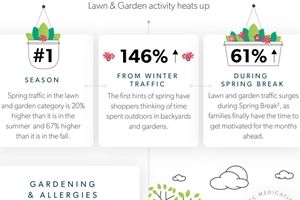
When the calendar turns to spring every year (and the weather actually cooperates), most people begin an annual rite of passage: We stuff coats into closets, dust off the deck furniture, and begin the ritualistic process of decluttering the house from the winter shut-in.
We also do a few other things with relative predictability: We shop. A lot.
As the winter months wane and temperatures rise, shoppers start stocking up on spring essentials, according to analysis from Bazaarvoice compiled from shopper behavior on the company’s network of 5,700+ brand and retailer websites. Those “essentials” run the gamut—from the obvious, such as cleaning supplies and garden equipment, to the less obvious, such as that one-of-a-kind prom dress.
A few of the more interesting findings from the research:
- Web traffic for dresses is 16% higher in the spring than in the summer. In late April, traffic increases even more as high schoolers around the country prep for graduation parties and proms. The bottom line: it doesn’t need to be dress season for shoppers to start thinking about dress season.
- Lawn and garden traffic surges during spring break. In fact, it goes up a remarkable 61% during spring break week.
- Spring holidays are starting to rival Black Friday. Well, maybe that’s a little hyperbolic, but spending on St. Patrick’s Day was expected to be $5.3 billion in 2018, and Easter candy sales alone were projected to be $2.6 billion. But both are dwarfed by Mother’s Day, for which spending was $24.6 billion in 2017, with jewelry-related pageviews soaring 36% before Mother’s Day.
What’s Driving All That Spending?
Maybe it’s being cooped up all winter. Maybe it’s the desire to freshen up our wardrobes. Or maybe it’s another “holiday”—everyone’s favorite—that gets us all feeling financially active: Tax Day.
Tax Day has a way of creeping up on all of us, Bazaarvoice’s analysis found. Though many people begin thinking about taxes as soon as their documents start flowing into their mailboxes, many tax-filing software purchases are made at the last-minute, the data confirmed. The week of Tax Day, tax software traffic increased 50% over the prior month. And that one week accounted for 18% of all spring pageview traffic in the category.
What continually drives spending? Reviews.
In fact, consumers often turn to authentic reviews to validate decisions, particularly in specific categories. With vacuum-cleaner purchases, for instance, 75% of online shoppers read a review before making a purchase.
Bazaarvoice found similar numbers in the lawn care (69%), tools (61%), and dresses (60%) categories.
What Can Marketers Learn From the Data?
There are a four key takeaways that e-commerce marketers in particular can learn from this research—and not just that they should start budgeting for their daughter’s prom dress in January.
- It’s hard to plan if you can’t forecast what’s important: Data can tell you a lot about buyer behavior and focus areas. If you recognize and plan for seasonal behavior shifts that might cause significant traffic changes in your category, you’ll get out ahead of those trends by offering the right products and offers.
- When the weather heats up, so does the focus on major milestones: Spring and summer are often the seasons for big events—proms, weddings, graduations, etc. Plan accordingly, and it can pay off big.
- Weather and holidays affect sales, but timing is everything: By knowing when people start shopping for specific items, you can make sure your brand is in front of buyers at their moment of interest, rather than waiting until their mind is already made up.
- Reviews influence behavior, particularly for big spring purchases: This is particularly true for high-investment or technical purchases, or big-decision items such as formal dresses.
What else can marketers and advertisers do to increase awareness and sales during the spring months?
There are clear events and trends during spring that relate to shopping spikes. If you sell products in any related categories, harness your own transaction and website data—and tools like Bazaarvoice—to inform the timing, messaging, and targeting of your spring retail strategy.
